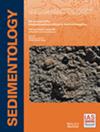进一步了解具有非平面表面的钙镁碳酸盐:实验方法
IF 2.8
2区 地球科学
Q1 GEOLOGY
引用次数: 0
摘要
鞍状白云石是一种钙镁碳酸盐岩,其特征是晶体面弯曲、劈理弯曲以及在交叉偏振光下出现扫射消光。鞍状白云石以及一般具有弯曲晶面的钙镁碳酸盐通常被归入埋藏(热液)领域,并可作为沉积盆地和造山运动中水文地球化学过程的替代档案。目前,导致这些奇特翘曲碳酸盐形成的物理化学条件尚不清楚,而导致其晶格弯曲的机制也存在争议。本研究利用实验室实验评估了控制具有弯曲晶面的碳酸盐形成的因素,这些因素是流体温度、反应物大小、流体盐度和流体镁钙比的函数。结果表明,在较宽的流体盐度范围(5 至 40 wt.%)内,富含钙的流体(镁:钙 = 0.43)在较高温度(约 220°C)下会形成一系列具有弯曲表面的镁方解石。在斜长石或鞍状白云石基质上外延成核的镁方解石表面呈翘曲状,而在方解石种子上成核的镁方解石则表面平坦。虽然这两种晶体习性可以共存,但具有弯曲晶面(Mg : Ca 值为 0.35 至 0.40)的镁方解石往往比具有平坦晶面(Mg : Ca 值为 0.58 至 0.74)的镁方解石富含更多的钙。在流体温度较高(230°C)的实验中,方解石反应物被显示平面晶面的白云石取代。这些结果共同表明,具有翘曲表面的钙镁碳酸盐的形成很可能与地球化学和物理参数的组合以及各种阈值极限有关,而不是像文献中通常报道的那样只与一个特定参数有关,例如流体温度升高。虽然目前的实验沉淀物大多是晶面弯曲的无序菱镁方解石,但在初步工作假设的层面上,这些沉淀物代表了许多在埋藏环境中常见的古鞍白云岩的前身,这是合理的。本文章由计算机程序翻译,如有差异,请以英文原文为准。
Towards an improved understanding of Ca–Mg carbonates with nonplanar surfaces: An experimental approach
Saddle dolomite is a Ca–Mg carbonate characterized by curved crystal faces, curved cleavage and sweeping extinction under cross‐polarized light. Saddle dolomite and, generally, Ca–Mg carbonates with curved crystal faces, are often assigned to the burial (hydrothermal) realm and serve as proxy archives for hydrogeochemical processes in sedimentary basins and orogens. At present, the physicochemical conditions leading to the formation of these peculiar warped carbonates are unclear, and the mechanisms inducing the curvature of their crystal lattice are debated. This study uses laboratory experiments to assess the factors controlling the formation of carbonates with curved crystal faces as a function of fluid temperature, reactant size, fluid salinity and fluid Mg : Ca. Results show that a range of magnesium calcites with curved surfaces form at elevated temperatures (ca 220°C) from calcium‐rich fluids (Mg : Ca = 0.43) within a wide range of fluid salinities (5 to 40 wt.%). Magnesium calcites that nucleate epitaxially on rhombohedral or saddle dolomite substrates exhibit warped surfaces, while those that nucleate on calcite seeds form flat surfaces. Although the two crystal habits can co‐occur, Mg‐calcites with curved crystal faces (Mg : Ca of 0.35 to 0.40) tend to be more calcium‐rich than those with flat faces (Mg : Ca of 0.58 to 0.74). In experiments with higher fluid temperature (230°C), calcite reactants undergo replacement by dolomite exhibiting planar crystal faces. The results collectively indicate that the formation of Ca–Mg carbonates with warped surfaces is likely related to a combination of geochemical and physical parameters and various threshold limits, as opposed to one specific parameter, for example, elevated fluid temperature, as is commonly reported in the literature. Although most of the present experimental precipitates are disordered magnesian calcites with bent crystal faces, it is reasonable, at the level of a tentative working hypothesis, that these represent precursors of many ancient saddle dolomites commonly found in burial settings.
求助全文
通过发布文献求助,成功后即可免费获取论文全文。
去求助
来源期刊

Sedimentology
地学-地质学
CiteScore
8.20
自引率
11.40%
发文量
94
审稿时长
6-12 weeks
期刊介绍:
The international leader in its field, Sedimentology publishes ground-breaking research from across the spectrum of sedimentology, sedimentary geology and sedimentary geochemistry.
Areas covered include: experimental and theoretical grain transport; sediment fluxes; modern and ancient sedimentary environments; sequence stratigraphy sediment-organism interaction; palaeosoils; diagenesis; stable isotope geochemistry; environmental sedimentology
 求助内容:
求助内容: 应助结果提醒方式:
应助结果提醒方式:


